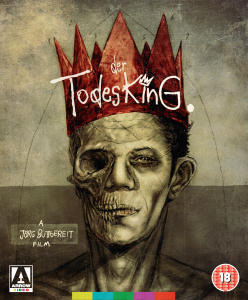 The king of death resides resplendent on his throne, it will not be too long before you sit at his feet, it could happen in an instant, a heartbeat. It could take a long suffocating agony, the release from which you find yourself begging for. What happens after a final breath is taken nobody truly knows; nothingness is most likely. Welcome to Der Todesking (1990) Jorg Buttgereit’s unflinching look at the futility of life and death, this is not a feel good movie, be warned. Following on from his transgressive and seminal feature Nekromantik (1987) Buttgereit delved deeper into taboo subjects with this meditative study of death. It follows in the footsteps of the mondo and documentary styled films that sprang up in the 70’s such as the renowned Faces Of Death series, themselves stemming from the works of Italian filmmakers Jacopetti and Prosperi such as Mondo Cane (1962). After a rapid and underground (i.e. banned in countries like the UK) influx of such films taking things as far as they could go, they pretty much died a natural death themselves. Their audience had been satiated by stark and sobering images that even went as far as depicting the mysteries of what happens when the body is left on the slab for autopsy and embalmment.
The king of death resides resplendent on his throne, it will not be too long before you sit at his feet, it could happen in an instant, a heartbeat. It could take a long suffocating agony, the release from which you find yourself begging for. What happens after a final breath is taken nobody truly knows; nothingness is most likely. Welcome to Der Todesking (1990) Jorg Buttgereit’s unflinching look at the futility of life and death, this is not a feel good movie, be warned. Following on from his transgressive and seminal feature Nekromantik (1987) Buttgereit delved deeper into taboo subjects with this meditative study of death. It follows in the footsteps of the mondo and documentary styled films that sprang up in the 70’s such as the renowned Faces Of Death series, themselves stemming from the works of Italian filmmakers Jacopetti and Prosperi such as Mondo Cane (1962). After a rapid and underground (i.e. banned in countries like the UK) influx of such films taking things as far as they could go, they pretty much died a natural death themselves. Their audience had been satiated by stark and sobering images that even went as far as depicting the mysteries of what happens when the body is left on the slab for autopsy and embalmment.
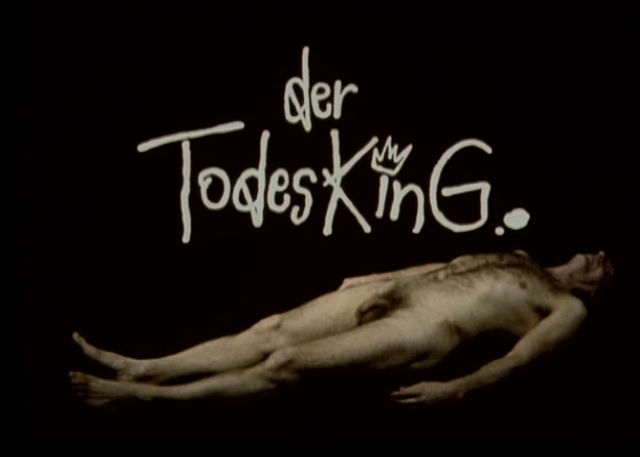
Having already proved unconventional as a filmmaker and one who did not follow narrative rules Der Todesking still came as a shock in both subject and structure for those of us who sought it out after release. Essentially the film takes us through a week of death, divided by days and events. A man leading a humdrum existence takes a last bath floating off on a cocktail of pills, another shoots his girlfriend and hangs himself, a park bench chat ends in brains blown out. Nothing is particularly explained. A corpse rots in time-lapse photography between each vignette. This was something that was undoubtedly as painful for the director to stage as for us to watch, as his mother having died of cancer during production was going through a similar metamorphosis of the flesh. We continue and one of the bleakest segments simply sees camera traverse the lengths of a bridge, the names, ages and occupations of those we assume have taken their final journey from it displayed on the screen. A chain letter arrives at a crumbling looking tenement building, it advocates death, will the unhappy and obviously lonely woman reading it observe its orders? Long before mobile recording was part of everyday life a woman straps up a cumbersome camera and rig and somewhat presciently kills band members and audience at a rock concert. The last day simply gives me a headache.
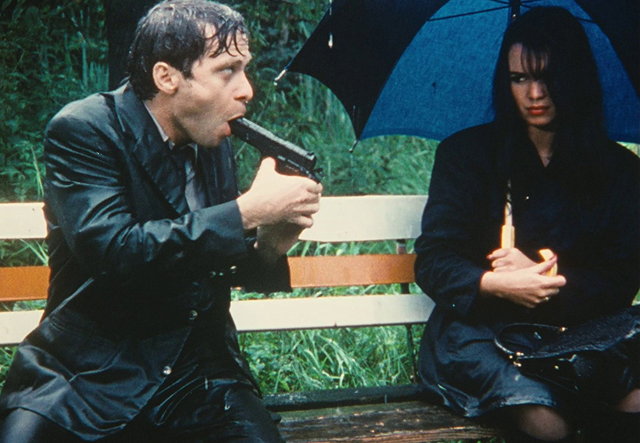
What is essentially different from many of the shockumentaries around in the 80’s apart from the fact we know this is being filmed in a fictional way rather than pretending to be real and in many cases not being so, is that it is not particularly exploitative. Der Todesking is more a case of being a voyeur to death in a more natural everyday state. The one real exception to this is the murder, suicide section which sees the killer getting deranged whilst watching a knock off Ilsa naziploitation film at home before committing his misdeeds. The fact it is a German film displaying swastikas is perhaps surprising enough but be prepared for one hell of an eye watering scene which I can tell you is back in the film uncensored compared to the film’s previous limited release on UK video. An interesting aside is the fact that the film was also kind of repeated too just couple of years later by the grizzly and also unforgettable Suicide by Raoul W. Heimrich & Yvonne Wunschel (2001). If you want to go for a particularly difficult double bill, there’s your answer.
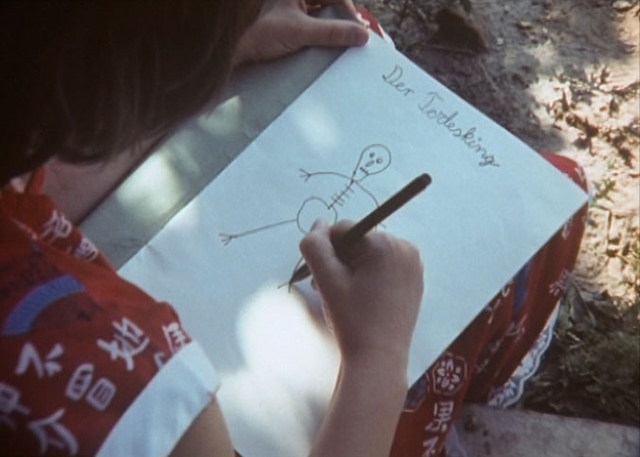
There is no two ways about the fact that Der Todesking has a cult following about it and has fascinated many people who have seen it. It has also probably shocked as many due to the stark realism of the film and I have to wonder how many collectors of Arrow’s output will be getting shot of this as quickly as the limited edition arrives (mine is on pre order and will sit alongside my German Target DVD). Arrow are, like with Nekromantik 1 and 2, releasing it completely uncut for the first time in the UK with stacks of special features in a glorious presentation box along with the soundtrack which is essential listening, the music and visuals totally complimenting each other. There’s even a copy of the chain letter included. I can’t comment much more upon that till it arrives or unfortunately the upgrade in quality of the Blu-Ray as sitting down to watch my preview copy I realised I had been sent it on DVD. Luckily I am still able to talk about the extras which I was as equally excited about.
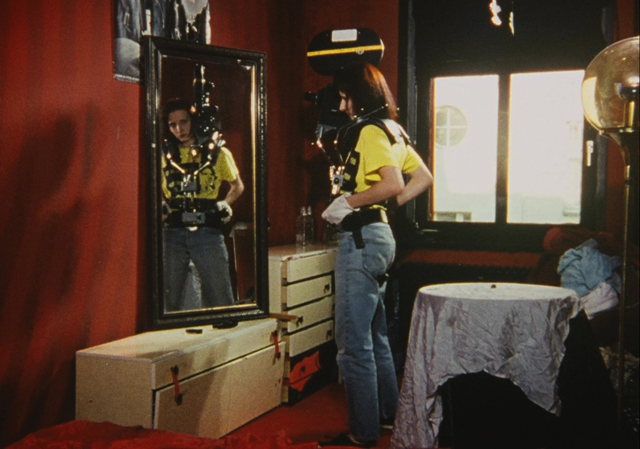
Rather than making any new films lately (a short segment in German Angst being the exception) Buttgereit has been over here a fair bit presenting his past movies. First feature up is a conversation piece between him and Graham Rae at the 2016 Manchester Festival Of Fantastic Films. They chat about his early monster film infatuation onto his short movies and first feature Nekromantik. The directors English is very good and sound is nice and clear. Although Germany was censorious with many films being banned, an early experience at a Throbbing Gristle concert and them screening shock footage as they played created an early influence. Although I have not mentioned cast and crew in review a lot of people who were similarly interested in the underground horror oeuvre such as producer Manfred O. Jelinski, actor Daktari Lorenz, musician / actor Hermann Kopp and writer Franz Rodenkirchen are put in context. The parts they played in the movies development is discussed and how they become part of a stable of like-minded collaborators. Parallels are drawn to the intellectual influence in his films of Ted Bundy as well as some surprise news of the first segment of Der Todesking being dramatized from a real life event. As for the Naziploitation sub-genre the director affirms that these films simply “don’t exist” in Germany. Apparently Buttgereit was invited to a black metal festival in Bergan (I’m guessing Hole In The Sky) and had no idea how influential Der Todesking was on the scene there. As many readers here no doubt are aware Hoest of Taake is just one of many who sport the death king tattoo; apparently the two met there. Insightful questions and very good answers this is a great 36 minute feature. ‘Todesmusik’ a short piece follows with the aforementioned Kopp. His music featuring grand piano and grating string concertos is guaranteed to haunt as much as the visual elements of the films themselves. I already have all the soundtracks and can contest they are fascinating, once in your head they are near impossible to shift going round like a fever dream. Plenty to learn here such as the fact the stylised grating sound from The Texas Chainsaw Massacre was utilised as an influence by Kopp on the macabre violin concertos on Nekromantik. He also tells us about acting as the bathtub suicide as well as (de)composing the music that goes with his watery demise.
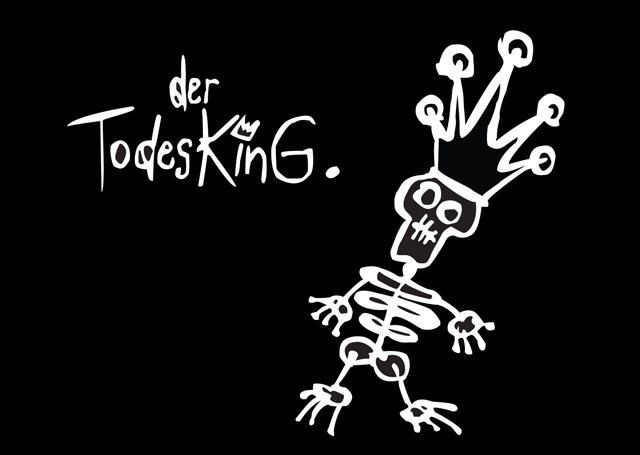
Next Graham Rae discusses how the films of Buttgereit get under the skin literally and the cult of tattoos and even scarification attributed to them, this comes complete with complimentary gallery and footage of him getting his own permanent death king. There’s a 16 minute vintage making of which can be watched in English or German with subs, those with this on DVD will have seen this before. It primarily talks about the difficulties of filming the bridge scene and shows the construction of the corpse; no they did not use a real one. The chain letter is shown in English as opposed to German as it was in the original UK video release. Then we all have corpse cake, Berlin 1990 at the premiere of the film. There’s a couple of short films from Manfred Jelinski ‘Die Reise ins Licht’ (1972) and Geliebter Wahnsinn (1973). I can’t imagine these having been widely available, certainly not in the UK. Here they are though with subs and optional commentary. At 25 mins long the first is an oddly engaging, atypical slice of 70’s, ‘end of the world, dystopian sci-fi. The second is only 8 mins and probably only makes sense to a student experimenting heavily with film and drugs. Buttgereit gets a short too Der Golleb (1983) 26 mins. The director plays a cop up against a giant mutating pizza monster (yes really) in a low budget effort that would even give the likes of Andreas Schnaas and Olaf Ittenbach a run for their money. Crème de la crème or maybe black forest gateaux is Corpse Fucking Art, the delightfully entitled 1987 documentary exploring the making of the first three feature films. I was particularly pleased to get this as some sod nicked my old bootleg VHS copy and I have been unable to get it again until now. I could write about this in detail too but would end up repeating myself a fair bit and this review is already quite long enough as it is. Now all we need is Schramm and if Arrow with an obliging BBFC can pull that off, the quartet is complete.
“That’s the death king. He makes people want to stop living”
Pete Woods
https://arrowfilms.com/product-detail/der-todesking-dual-format-cd/FCD1699

08/03/2019 at 3:52 am
Good review. Thanks for writing it. Glad you liked the extras. I put everything I had into coming up with different information for the interview I did with Jorg, including the bit about the politician dying in the bath. Glad you enjoyed it. Cheers.